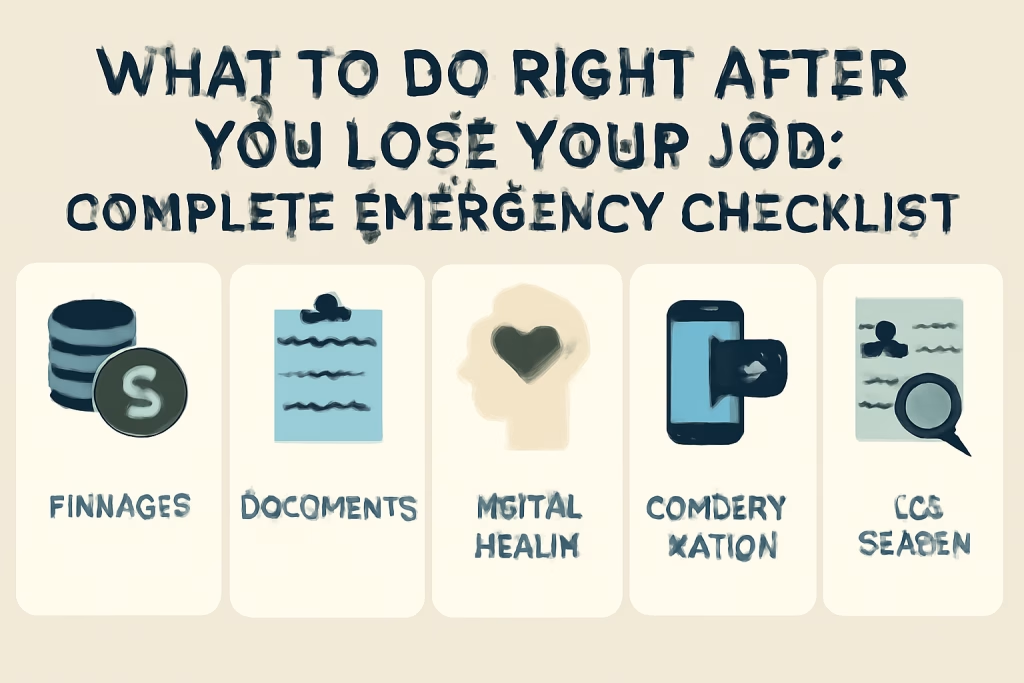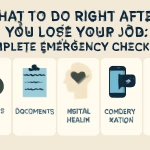Losing your job is one of life’s most stressful experiences, but taking the right actions in the first 24-48 hours can make the difference between chaos and controlled recovery. Here’s what you need to do immediately: file for unemployment benefits within the first week, secure COBRA health insurance within 60 days, create an emergency budget focusing on essential expenses only, update your LinkedIn profile, and reach out to your professional network. These five critical steps will stabilize your situation and position you for a successful job search.
With the U.S. unemployment rate at 4.2% as of July 2025 and the average job search taking 27 weeks for laid-off workers, having a structured emergency plan is essential. Research shows that people who lose their jobs experience more than twice the number of mentally unhealthy days compared to those who remain employed. However, over 70% of laid-off individuals find new jobs within three months when they follow a strategic approach.
Why Your Brain Isn’t Working Normally
When you lose your job, your brain enters survival mode. This isn’t weakness – it’s biology. Understanding what’s happening in your mind helps you make better decisions during this critical period.
Job loss triggers your body’s fight-or-flight response. Your brain floods with cortisol and adrenaline, the same chemicals released during physical danger. This hormonal surge impairs your:
- Memory formation and recall
- Decision-making ability
- Concentration and focus
- Emotional regulation
Research from the e61 Institute shows that self-reported mental health falls by 1.7% in the year before job loss and 2.9% in the year following termination. This means your brain isn’t functioning at full capacity when you need it most.
The 20-Minute Rule for Emotional Regulation
Before making any significant decisions, use this simple breathing technique:
- Breathe in for four counts
- Hold for four counts
- Breathe out for six counts
- Repeat for 20 minutes
This activates your parasympathetic nervous system and reduces cortisol levels. Only after this should you:
- Call your spouse or family
- Review termination documents
- Plan your next steps
Creating a Decision Buffer
Don’t sign any documents immediately. Inform your employer that you require 24-48 hours to review severance agreements or non-disclosure agreements. This isn’t just good practice – it’s legally competent. Many employment lawyers offer free consultations for reviewing termination packages.
Emergency Hour-by-Hour Action Plan (First 24 Hours)
Time is critical after a job loss. This timeline ensures you don’t miss important deadlines or opportunities.
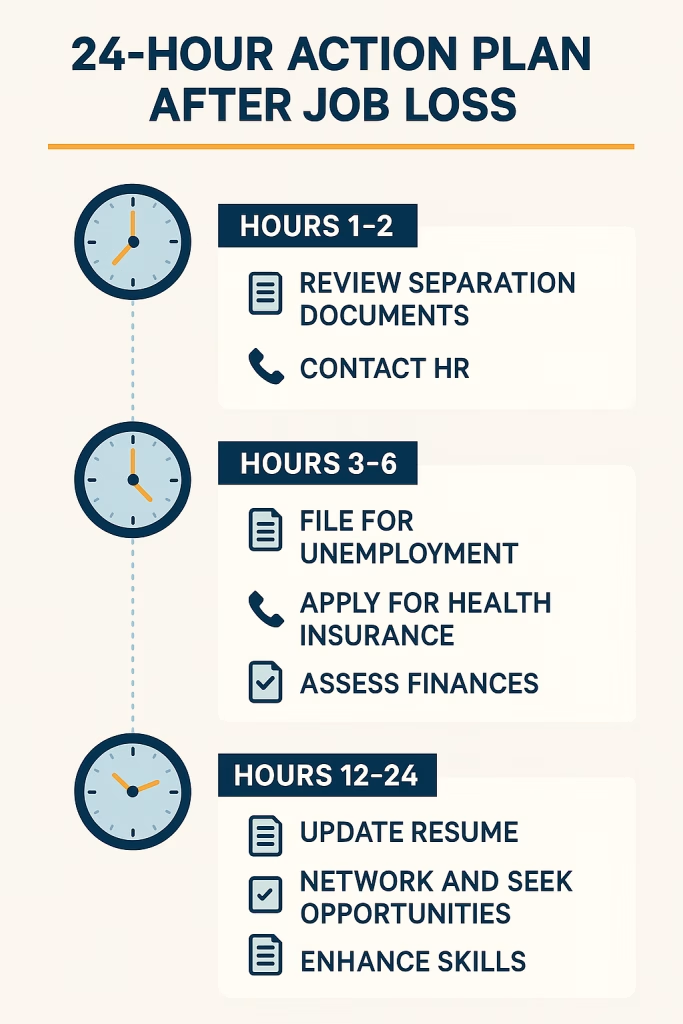
24-hour emergency action plan timeline infographic for immediate job loss response
Hours 1-2: Immediate Information Gathering
Stay professional during your termination meeting. Take notes on:
- Reason for termination (reduction in force, performance, etc.)
- Final work date and last paycheck date
- Unused vacation time payout
- Severance package details
- Company property to return
- References they’ll provide
Request these documents in writing:
- Termination letter with specific reasons
- COBRA enrollment information
- 401(k) rollover paperwork
- Final paycheck breakdown
- Unemployment insurance information
Digital Asset Preservation (Do This Immediately):
Your company may revoke access to email and files within hours. Before they do:
- Download personal files (legally obtained only)
- Export LinkedIn connections to CSV
- Save contact information for references
- Take screenshots of performance reviews
- Backup work samples you created
It’s important to note that you should only save materials you created or have the legal right to. For instance, you can save personal documents, performance reviews, and work samples you created. However, you should not take proprietary company information.
Hours 3-6: Legal and Administrative Tasks
COBRA Health Insurance Setup
You have 60 days to enroll in COBRA, but start the process immediately. COBRA costs range from $400-$700+ monthly for individuals, with family coverage reaching $2,000-$4,000+ monthly.
COBRA vs. Marketplace Insurance:
- COBRA: Keep the same doctors and coverage, but it’s expensive
- ACA Marketplace: Often cheaper, especially for lower-income. Special Enrollment Period: Job loss qualifies you for immediate marketplace enrollment
Unemployment Benefits Application
File within the first week of job loss. Each state has different requirements, but you’ll typically need:
- Social Security number and birth date
- Employment history for the past 15-18 months
- Employer names, addresses, phone numbers
- Start/end dates for each job
- Reason for leaving each position
- Bank account information for direct deposit
Average unemployment benefits by state range from $200-$600 weekly. The process can take 2-4 weeks, so apply immediately.
Hours 12-24: Financial Emergency Assessment
The 24-Hour Financial Snapshot
Create this emergency budget worksheet:
Essential Monthly Expenses:
- Housing (rent/mortgage): $______
- Utilities (electric, gas, water): $______
- Food/groceries: $______
- Transportation: $______
- Insurance premiums: $______
- Minimum debt payments: $______
- Total Essential Expenses: $______
Available Resources:
- Emergency savings: $______
- Final paycheck: $______
- Unused vacation payout: $______
- Severance pay: $______
- Total Available Cash: $______
Divide your total available cash by your monthly essential expenses to determine your financial runway. Your financial runway is the number of months you can cover your basic expenses with your available cash. If you have less than 3 months of coverage, you need to act fast on expense reduction to extend your financial runway.
The 72-Hour Financial Triage System
Think like a combat medic. Some financial obligations are life-critical; others can wait. This triage system is designed to help you stay organized and in control, preventing you from wasting energy on the wrong priorities.
Priority Level 1: Life-Critical Expenses (Next 30 Days)
These payments keep you housed, fed, and able to job search:
- Housing payments – Contact the lender immediately if you can’t pay
- Utilities – Most companies offer hardship programs
- Health insurance – COBRA or marketplace enrollment
- Transportation – Car payment, insurance, gas for interviews
- Basic groceries – Cut dining out completely
- Medications – Check manufacturer assistance programs
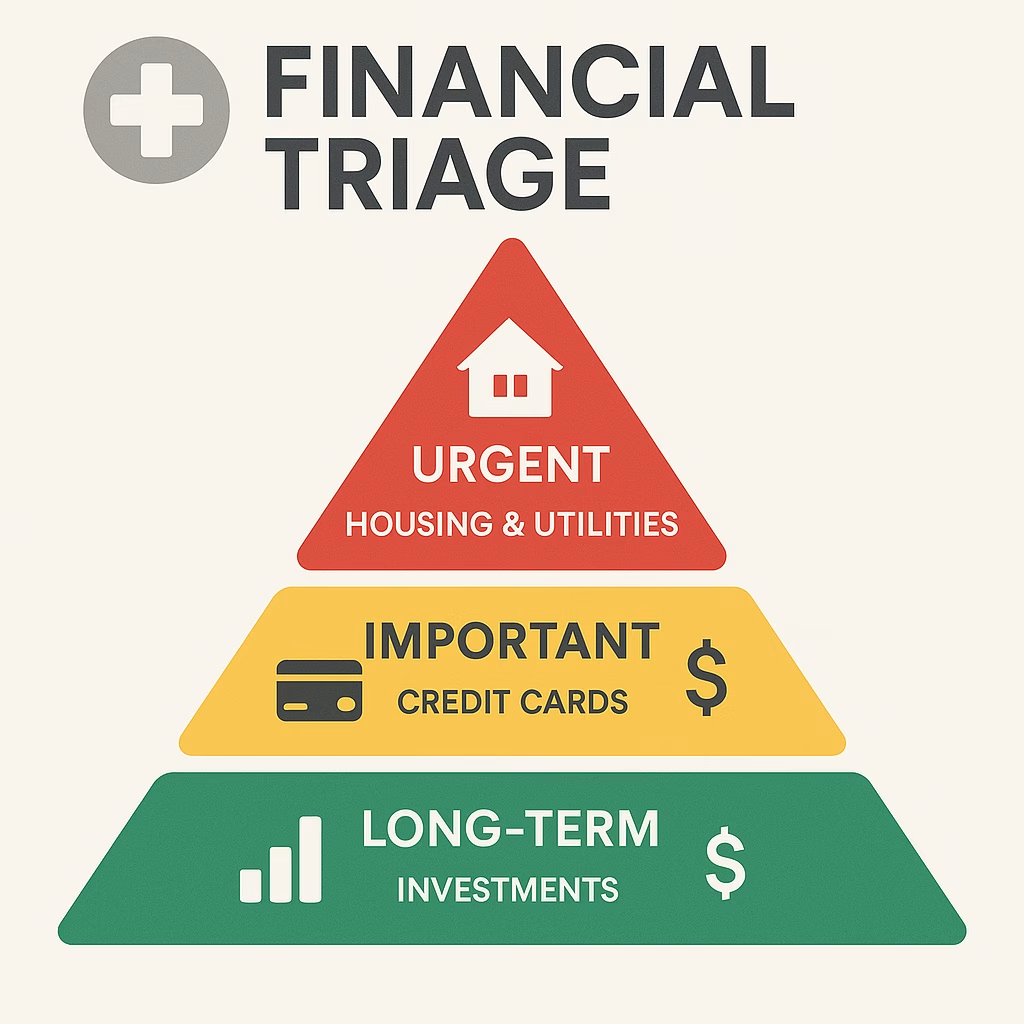
Financial triage system showing priority levels for expenses after job loss
Priority Level 2: Important but Deferrable (30-90 Days)
- Credit card minimum payments – Call companies to discuss hardship programs
- Student loans – Apply for forbearance or income-driven repayment
- Non-essential subscriptions – Cancel streaming services, gym memberships
- Life insurance premiums – May have a 30-day grace period
Priority Level 3: Long-term Considerations (90+ Days)
- Investment contributions – Pause 401(k) contributions if needed
- Non-essential insurance – Review extended warranties, disability insurance
- Home improvements – Delay all non-emergency repairs
- Entertainment expenses – Eliminate during active job search
Emergency Budget Creation Tool
Financial experts recommend the 50/30/20 rule, but unemployment requires the 80/20 rule:
- 80% of available funds for essential expenses
- 20% for job search activities (networking events, interview clothes, transportation)
Eliminate all discretionary spending until you have a job offer in hand.
Strategic Communication: Who to Tell, When, and How
How you communicate your job loss is a strategic decision that can affect your reputation and job search success. Here’s a thoughtful timeline for different audiences, helping you navigate this challenging period with grace and professionalism.
Immediate Circle (Hours 1-24)
Family Communication Framework:
- Spouse/Partner: Tell them first, privately, with a plan
- Children: Age-appropriate explanation focusing on the temporary nature
- Parents/Siblings: Brief update, concentrate on your action plan
Sample script for spouse: “I was laid off today due to company restructuring. I’ve already started the unemployment process and have X months of expenses saved. Here’s my plan for the next 30 days…”
Professional Network (Days 1-3)
LinkedIn Announcement Strategy:
Update your headline and status carefully. Avoid these mistakes:
- ❌ “Recently laid off and looking for opportunities”
- ❌ “Unemployed and desperate for work”
- ❌ “My company made a huge mistake.”
Instead, use this approach:
✅ “Experienced Marketing Manager exploring new opportunities in fintech and healthcare”
Reference Contact Outreach:
Send this message template within 48 hours:
“Hi [Name], I wanted to let you know that my position at [Company] was eliminated due to restructuring. I’ve really valued working with you and would appreciate if you’d be willing to serve as a reference. I’m exploring opportunities in [specific field] and would love any insights you might have. Thanks for all your support over the years.”
Social and Community (Week 1-2)
Reputation Management:
- Never badmouth your former employer publicly
- Focus on what you learned and achieved
- Emphasize your excitement for new opportunities
- Join industry groups and professional associations
The “Elevator Pitch” for Your Situation
Prepare these 30-second responses:
For “What happened at your job?”
“The company restructured their marketing department and eliminated several positions including mine. I’m excited to apply my digital marketing expertise to a growth-stage company in the healthcare space.”
For “How are you doing?”
“I’m doing well, thanks. This is actually great timing for me to explore some opportunities I’ve been interested in. Do you know anyone in the biotech industry I should connect with?”
Mental Health and Emotional Resilience Protocol
Job loss grief is real. Research shows unemployed people report more than twice the number of mentally unhealthy days compared to employed people. Here’s how to protect your mental health during the job search.
The Job Loss Grief Cycle
Expect to experience these stages (not necessarily in order):
- Shock (Days 1-3): Disbelief, numbness
- Anger (Days 3-14): Frustration at company, self, or situation
- Bargaining (Weeks 2-4): “If only I had worked harder”
- Depression (Weeks 4-8): Sadness, isolation, hopelessness
- Acceptance (Weeks 6-12): Energy returns, future focus
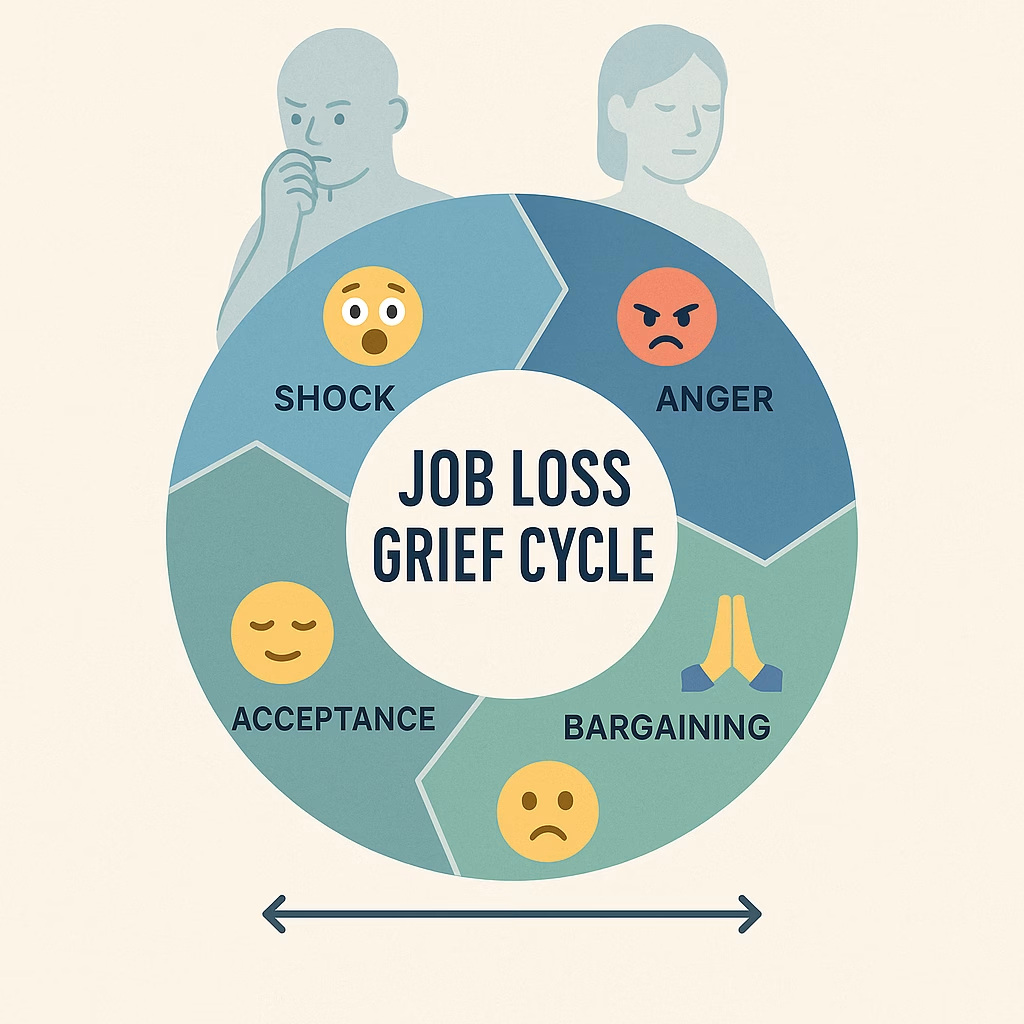
Job loss grief cycle infographic showing 5 emotional stages and timeline
Healthy processing signs:
- Talking to friends and family
- Maintaining basic self-care
- Taking action on a job search
- Exercising regularly
Concerning signs requiring professional help:
- Complete withdrawal from others
- Substance abuse increases
- Sleep disruption lasting weeks
- Suicidal thoughts
Daily Mental Health Maintenance
Morning Routine Restructuring:
Without a work structure, create your own:
- 7:00 AM: Wake up at normal work time
- 7:30 AM: Exercise (even 20-minute walk)
- 8:30 AM: Healthy breakfast
- 9:00 AM: Dress professionally
- 9:30 AM: Job search activities begin
Evening Reflection Protocol:
Before bed, write down:
- One thing you accomplished (however small)
- Three things you’re grateful for
- Tomorrow’s priority task
This prevents the mental spiral that often happens at night.
Support System Activation
Professional counseling options:
- Many insurance plans cover mental health
- Employee Assistance Programs (EAP) from former employers
- Community mental health centers
- Online therapy platforms (BetterHelp, Talkspace)
Support groups:
- LinkedIn job seeker groups
- Local unemployment support groups
- Industry-specific networking groups
- Career transition meetups
Avoiding Common Psychological Traps:
- Social media comparison: Limit LinkedIn browsing to job search only
- Isolation: Schedule daily human contact
- Overactivity avoidance: Balance job search with rest
- Perfectionism: Apply to good-fit jobs, not just perfect ones
The Technology and Security Checklist
Modern job loss requires digital security measures that didn’t exist decades ago. Protect your data and optimize your online presence.
Personal Data Protection
Immediate Security Steps:
- Change passwords for personal accounts if you used them at work
- Enable two-factor authentication on all crucial accounts
- Review cloud storage – separate personal from work files
- Update recovery emails – don’t use work email for personal accounts
Work Device Return:
- Wipe personal data from work devices before returning
- Transfer photos and documents to personal storage
- Remove work email from personal devices
- Cancel auto-login for work applications
Professional Online Presence Optimization
LinkedIn Profile Emergency Update:
Your LinkedIn profile becomes your primary professional presence. Update these sections immediately:
Headline optimization:
- Include target role and key skills
- Use keywords recruiters search for
- Show the value proposition clearly
Example: “Senior Product Manager | SaaS Growth Expert | Led 3 Products from $0 to $10M ARR”
Summary rewrite strategy:
- Lead with your most significant achievement
- Include 3-4 key skills with examples
- End with what you’re seeking
Skill endorsement campaign:
- Add 15-20 relevant skills
- Ask former colleagues for endorsements
- Endorse others to increase visibility
Job Search Technology Stack
Essential platforms to set up:
- LinkedIn Premium – Increases visibility to recruiters
- Indeed – Set up job alerts for your criteria
- Glassdoor – Research companies and salaries
- AngelList – For startup opportunities
- Industry-specific boards – Dice (tech), BioPharma Dive (life sciences)
Application tracking system:
Create a spreadsheet with these columns:
- Company Name
- Position Title
- Application Date
- Application Method
- Contact Person
- Follow-up Date
- Interview Scheduled
- Status
Interview technology testing:
- Test Zoom/Teams video and audio quality
- Check internet speed – minimum 25 Mbps for video calls
- Prepare backup connection – mobile hotspot if needed
- Set up a professional background or use a virtual background
Week 1-2: Building Momentum and Systems
The first two weeks determine whether you’ll have a strategic job search or a desperate scramble. Build these systems to stay organized and motivated.
The Job Search Operating System
Daily Time Blocking:
- 9:00-11:00 AM: Job applications and research (peak energy)
- 11:00 AM-12:00 PM: Networking and LinkedIn activity
- 1:00-3:00 PM: Skill development and learning
- 3:00-4:00 PM: Interview preparation and follow-ups
- 4:00-5:00 PM: Administrative tasks (expense tracking, benefits)
Energy Management:
Job searching is emotionally draining. Manage your energy like an athlete:
- High-energy tasks in the morning (applications, networking)
- Administrative tasks when energy dips
- Physical exercise to reset energy levels
- Social connection to prevent isolation
Productivity Metrics That Matter:
Track these weekly:
- Applications submitted
- New networking connections made
- Informational interviews conducted
- Skills learning hours
- Interview requests received
Aim for 10-15 quality applications per week, not 50 spray-and-pray applications.
Application Tracking System
Create this spreadsheet structure:
| Company | Position | Applied | Source | Contact | Status | Follow-up | Notes |
| TechCorp | PM | 8/1 | Jane Smith | Interview | 8/15 | Good culture fit |
Follow-up Schedule Automation:
- Week 1: Application submitted
- Week 2: Follow up if no response
- Week 3: Connect with hiring manager on LinkedIn
- Week 4: Final follow-up, then move on
Networking Acceleration Strategy
Research shows that 85% of jobs are filled through networking. Here’s how to activate your network quickly.
The 3-Touch Network Activation:
Touch 1: Announcement (Day 1-3)
“Hi [Name], I wanted to let you know I’m exploring new opportunities after my role at [Company] was eliminated in restructuring. I’d love to catch up and hear how things are going with you.”
Touch 2: Value-Add (Week 2)
“Hi [Name], saw this article about [industry trend] and thought you’d find it interesting given your work at [Company]. Hope you’re doing well!”
Touch 3: Specific Ask (Week 3-4)
“Hi [Name], I’m actively interviewing for senior marketing roles and would love 15 minutes of your time to get your perspective on the current market. Would you be available for a brief call this week?”
Quick Networking Wins:
- Former colleagues: Easiest warm connections
- Alum networks: School and company alum groups
- Industry events: Virtual and in-person meetups
- Professional associations: Join relevant organizations
- LinkedIn connections: Message 2nd-degree connections
Long-term Recovery and Career Pivot Planning
While you need to find income quickly, use this transition period to assess if you want to continue on the same career path or make strategic changes.

30-60-90 day job recovery plan showing key milestones and goals
The 30-60-90 Day Recovery Plan
30-Day Goals (Stabilization Phase):
- Unemployment benefits are approved and flowing
- COBRA or marketplace insurance is active
- Emergency budget implemented and tracking expenses
- LinkedIn profile optimized and generating views
- 50+ networking conversations completed
- 10+ job applications submitted to target companies
Success metrics: Financial stability achieved, job search system operational
60-Day Goals (Acceleration Phase):
- 3+ interviews scheduled or completed
- Professional references contacted and ready
- Skill gaps identified and learning plan active
- Industry connections expanded by 25%
- Preliminary job offers or second-round interviews
Success metrics: Active interview pipeline, market validation of your skills
90-Day Goals (Selection Phase):
- Multiple job offers to evaluate
- Salary negotiation strategy prepared
- Career trajectory decision made (same path vs. pivot)
- Professional relationships established for the future
- Emergency fund partially replenished from new job
Success metrics: New job secured, financial recovery begun
Career Pivot Evaluation Matrix
Use this framework to decide if you should stay in your current field or make a change:
Skills Transferability Assessment:
| Skill Category | Current Level | Market Demand | Transferable To |
| Technical Skills | Expert/Intermediate/Beginner | High/Medium/Low | [List industries] |
| Leadership | Expert/Intermediate/Beginner | High/Medium/Low | [List roles] |
| Communication | Expert/Intermediate/Beginner | High/Medium/Low | [List functions] |
Industry Analysis:
- Growth trajectory: Is your industry expanding or contracting?
- Salary trends: Are compensation levels increasing or stagnant?
- Remote work availability: Does the industry support flexible work?
- Ageism concerns: Will age discrimination limit opportunities?
Pivot Decision Framework:
- Same role, same industry: Fastest to employment, familiar territory
- Same role, different industry: Moderate timeline, skill transfer needed
- Different role, same industry: Leverage industry knowledge, learn new skills
- Different role, different industry: Longest timeline, highest risk/reward
The average career pivot takes 6-12 months longer than staying in the same field, but can result in 20-30% higher long-term earnings.
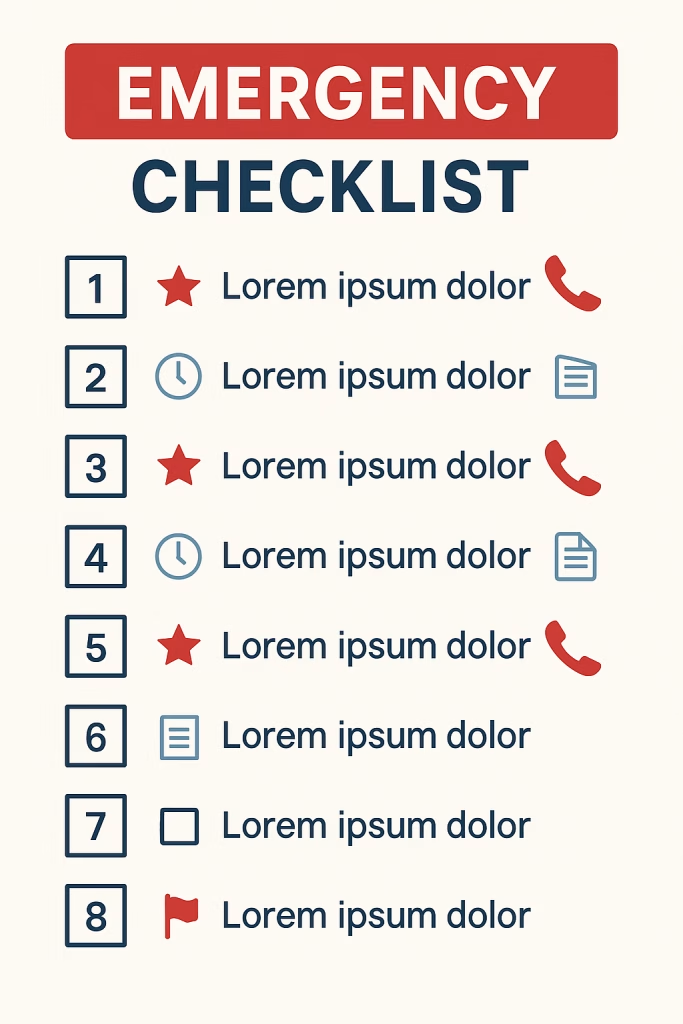
Emergency checklist infographic with critical actions to take immediately after job loss
The Ultimate Emergency Checklist and Resources
Use this checklist to ensure you don’t miss critical steps during the emotional stress of job loss.
Day 1 Emergency Checklist
Immediate Actions (Hours 1-6):
- [ ] Stay professional during termination meeting
- [ ] Request termination letter in writing
- [ ] Get COBRA enrollment information
- [ ] Download personal files before access is revoked
- [ ] Export LinkedIn connections
- [ ] Save reference contact information
Same Day Actions (Hours 6-24):
- [ ] Tell immediate family with an action plan
- [ ] Review severance/separation agreement (don’t sign immediately)
- [ ] Apply for unemployment benefits online
- [ ] Calculate emergency fund runway
- [ ] Update LinkedIn headline and status
Week 1 Checklist
Administrative:
- [ ] Complete unemployment benefits application
- [ ] Research COBRA vs. marketplace insurance
- [ ] Create emergency budget spreadsheet
- [ ] Set up job search email address
- [ ] Order business cards with new contact info
Professional:
- [ ] Update resume with recent accomplishments
- [ ] Request references from former colleagues
- [ ] Join industry groups on LinkedIn
- [ ] Set up job alerts on 3+ platforms
- [ ] Schedule 5 networking conversations
Month 1 Checklist
Job Search System:
- [ ] Application tracking spreadsheet created
- [ ] Daily job search schedule established
- [ ] Interview outfit selected and ready
- [ ] Elevator pitch practiced and refined
- [ ] Portfolio/work samples organized
Financial Management:
- [ ] Unemployment benefits received
- [ ] Health insurance coverage confirmed
- [ ] Non-essential expenses eliminated
- [ ] Emergency fund usage tracked
- [ ] Creditors contacted if payment issues
Essential Contact Directory
Financial Resources:
- Unemployment office: [Your state’s number]
- COBRA administrator: [From termination packet]
- Health insurance marketplace: 1-800-318-2596
- Credit counseling (non-profit): 1-800-388-2227
Mental Health Support:
- National Suicide Prevention Lifeline: 988
- Crisis Text Line: Text HOME to 741741
- Psychology Today therapist finder: psychologytoday.com
- BetterHelp online therapy: betterhelp.com
Career Resources:
- LinkedIn Premium support: linkedin.com/help
- Career transition coaching: [Local resources]
- Industry associations: [Relevant to your field]
- Professional development: coursera.org, udemy.com
State-Specific Resources
Unemployment Benefits:
- California: edd.ca.gov
- New York: labor.ny.gov
- Texas: twc.texas.gov
- Florida: floridajobs.org
- Find your state: CareerOneStop.org
Job Search Assistance:
- American Job Centers: careeronestop.org/LocalHelp
- SCORE mentoring: score.org
- Industry-specific job boards: [Research your field]
Conclusion: From Crisis to Opportunity
Losing your job feels like a crisis, but research shows it can become a career catalyst. Studies indicate that people who approach job loss strategically often end up in better positions than before. The key is taking immediate, structured action rather than hoping things will work out.
Remember these critical time limits:
- 60 days to enroll in COBRA health insurance
- 1 week to file for unemployment benefits
- 24-48 hours to download personal files
- 30 days to return company property
- 90 days to roll over 401(k) funds
Your immediate priorities are:
- Stabilize finances – unemployment benefits, emergency budget, health insurance
- Protect your reputation – professional communication, LinkedIn optimization
- Activate your network – former colleagues, industry connections, alumni
- Systematize your search – application tracking, daily routine, skill development
- Maintain mental health – exercise, social connection, professional support
The current job market shows mixed signals. While unemployment is at 4.2%, it’s taking an average of 27 weeks for laid-off workers to find new positions. However, 70% of laid-off individuals find new jobs within three months when they follow strategic approaches.
This crisis can become your opportunity if you:
- Use the time to learn new skills
- Expand your professional network
- Reassess your career goals
- Negotiate better terms in your next role
- Build stronger financial habits
The next few weeks will test your resilience, but thousands of people successfully navigate job transitions every day. Follow this checklist, stay consistent with your daily routine, and remember – this situation is temporary, but the skills and relationships you build during this time will benefit your entire career.
Your next job is out there. Now you have the roadmap to find it.
